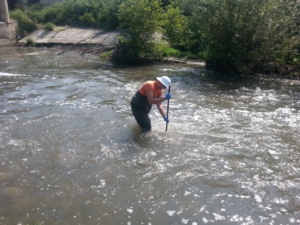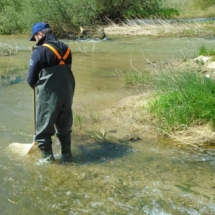Sampling of benthic macroinvertebrates takes place according to the standard EN 27828:1994, which have been canceled and replaced by ISO 10870:2012: «Water quality – Guidelines for the selection of sampling methods and devices for benthic macroinvertebrates in fresh waters», whereas Directive 2000/60 also refers to the use of specific hand-net (or kick-net). The latter is a D-shaped pond net consisting of an aperture area of 575 cm2, mesh size 0,09 cm, depth 27.5 cm and a pole height of 1,50 m. (ISO 10870:2012).
Picture 1. Hand net or kick net for invertebrate sampling
The sampling concerns a semi-quantitative 3-min kick and sweep method (Armitage and Hogger, 1994) plus 1-min sweeping of the bank vegetation when it exists (Wright, 2000; Kemitzoglou, 2004). Each sample consists of habitat types in relation to their spatio-temporal percentage of coverage according to the Habitat Matrix of the Sampling Protocol. Habitats of rivers are disturbed to the appropriate depth to ensure the capture of all taxonomic groups of the animal species depending on the composition of the substrate.
In very large rivers (> 10,000 km2), when depth is less than 1 m, sampling is performed by kick and sweeping in the river or along the littoral zone. Sampling of benthic macroinvertebrates is done using the sampler described above (ISO 7828:1985; EN 27828:1994) and the semi-quantitative 3-min kick and sweep method (Armitage and Hogger, 1994) covering all habitat types in relation to their spatio-temporal coverage rate. When the river is very deep because of the intense differences in habitat composition of the two banks of the lowland area of the large rivers, sampling is only performed on accessible micro-habitats of the two banks and not in the main course of the river.
Picture 2 a, b. Kicking and sweeping benthic macroinvertebrates from the river substrate into the net.
This special net is positioned vertically attaching with its horizontal side on the river substrate.; the performer stands with his feet in front of the D-shaped aperture opposite to the river flow direction kicking and sweeping benthic macroinvertebrates drift from the river substrate into the net without raising the net from the bottom for four minutes (3+1), dividing the time into the different habitats depending on their coverage. During sampling, all habitats are covered in each station (main canal, pools, point bars, islands) according to the Sampling Protocol (Chatzinikolaou et al., 2006, modified by Lazaridou et al., 2018).
The collected material is placed in plastic jars with 70-75% vol. alcohol solution. Station details are written on rice piece of paper and placed within the sample; these details are also written out of the plastic jar on a paper tape and outside the storage bag of each sample. Then the sample(s) is transferred to the laboratory to proceed with the determination of the collected benthic macroinvertebrates.
Armitage, P.D. & Hogger J. (1994). Invertebrate ecology and survey, 85-97, 151-159. In: RSPB, NRA & RSNC 1994 The New Rivers and Wildlife Handbook, pp.426. RSPB Sandy Bedfordshire UK.
Chatzinikolaou Y., Dakos V. & Lazaridou M. (2006). Longitudinal impacts of anthropogenic pressures on benthic macroinvertebrate assemblages in a large transboundary Mediterranean river during the low flow period. Acta hydrochim. Hydrobiol., 34, 453-463.
Directive 2000/60/EC, 2000. European Parliament and the Council (EC) 2000/60/EC of 23October 2000 on establishing a framework for Community action in the field ofwater policy. Off. J. Eur. Commun. L327, 1–72.
EN 27828:1994: Water quality – Methods of biological sampling – Guidance on handnet sampling of aquatic benthic macro-invertebrates.
EN 7828:1985. Water quality — Methods of biological sampling — Guidance on handnet sampling of aquatic benthic macro-invertebrates.
Kemitzoglou D. (2004). “The effectiveness of the semi-quantitative sampling method using benthic macroivertebrates.” Dissertation Thesis, Department of Biology, A.U.TH., Thessaloniki, p. 86.
Lazaridou M., Ntislidou Ch., Karaouzas I. & Skoulikidis N. (2018). Harmonization of a new assessment method for estimating the ecological quality status of Greek running waters. Ecological Indicators, 84, 683-694.
Wright, J.F., Winder, J.M., Gunn, R.J.M., Blackburn, J.H., Symes, K.L. and Clarke, R.T. (2000). Minor local effects of a River Thames power station on the macroinvertebrate fauna. Regul. Rivers: Res. Mgmt. 16: 159-174.


